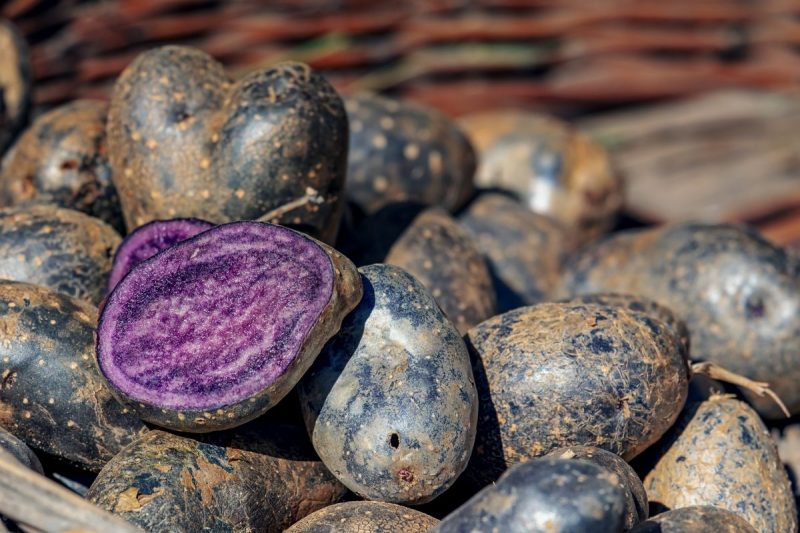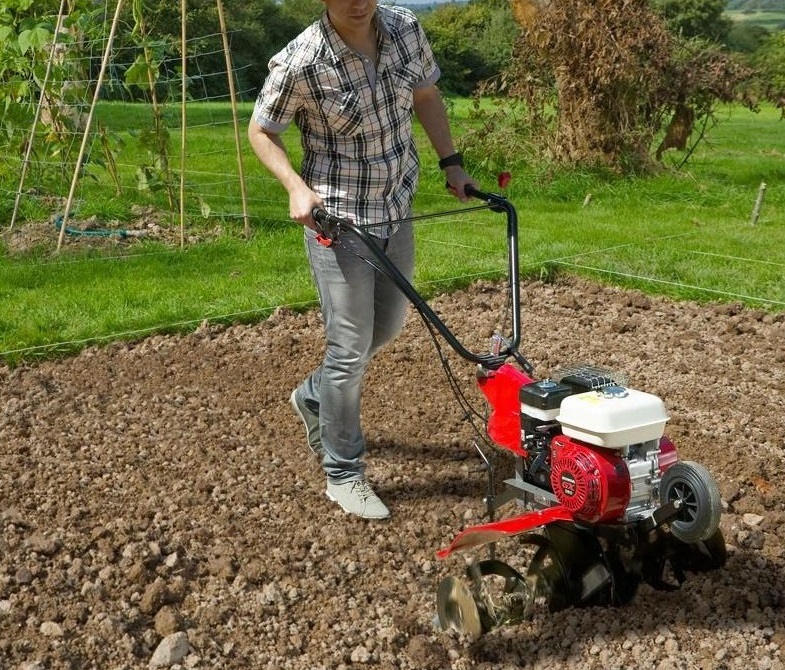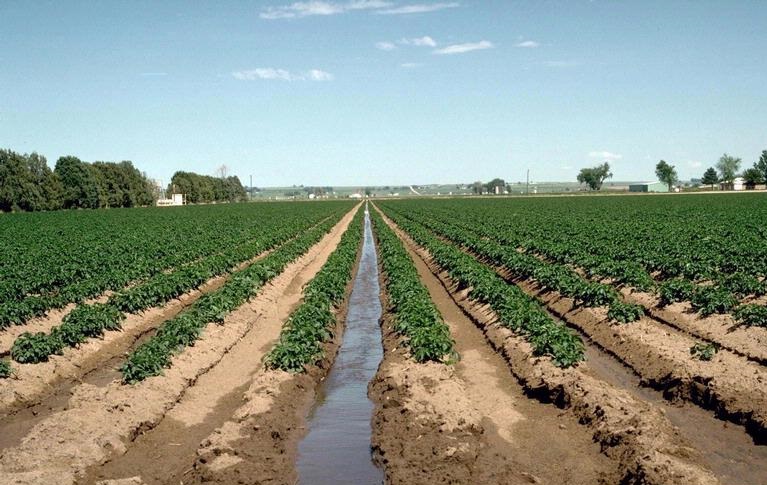Vitelotte, information about crop management

Vitelotte (Solanum tuberosum var. Vitelotte) is an exotic crop, which is beginning to make its way into local agriculture. Along with the sweet potato, the vitelotte crop is a niche one, which can bring important income to farmers.
Botanical particularities
In the area of origin, the vitelotte is a perennial plant that develops a fibrous, branched root with a high absorption capacity. Besides the aerial part, the potato also forms underground stems (stolons and tubers). Stolons are thickened branches of the underground stem and tubers are organs of the plant that accumulate large amounts of reserve substances.
The leaves are compound, with leaflets of different sizes, arranged alternately. The flowers are clustered in cymes and the corolla has various colors (white, violet, blue, pinkish-purple, yellowish). The fruit is a spherical berry and is not edible.
Climate and soil requirements
The roots start growing at 6-7℃, and the optimum temperature for plant growth and tuber formation is 22-27℃, depending on the stage of development. Temperatures above 40℃ negatively influence production. Insufficient light affects the growth of all plant parts, which negatively influences tuber production. Soil moisture should be maintained at 70-80% of field capacity for water. Insufficient moisture causes stunted tuber growth and excess moisture can lead to disease. It prefers light soils with a pH between 5 and 6.
Cultivation
Crop rotation
Potatoes should not be grown after other solanaceous plants. A 4-year rotation is recommended, but a 3 or 2-year rotation can also be used if no nematode attack has been reported. The best preceding crops for potatoes are straw cereals, clover, lucerne, annual legumes, maize, cabbage, flax, sunflower, root, or bulbous plants. Monoculture is not recommended.
Soil preparation
After clearing the field, a disc harrow can be used to destroy weeds and plant debris. Plowing should be carried out immediately at a depth of 28-30 cm. On compacted or heavy soils, the soil can be harrowed, as soil compaction considerably reduces potato production. After plowing, the soil should be leveled, an operation that has a positive influence on the subsequent work (planting, ridging, weeding, etc.).
Soil preparation for planting should be carried out at a depth of 14-18 cm, followed by ridging in furrows. The ridging helps the soil to warm up more quickly, reduces soil compaction, and eases access to the crop, thus reducing plant damage during care work. This work is carried out in several stages. The following work is carried out to restore the damaged ridges after the maintenance work. Ridging is mandatory in the case of irrigated crops.
Planting material and planting
It is recommended to use healthy material, free of diseases and pests. Pathogen-resistant varieties can also be used. Tubers can be treated with specific products before planting. The minimum vitelotte planting temperature is 7 ℃. Calendaristically, the planting season begins at the end of March.
Weed control
This work can be done mechanically or chemically. Chemically, with approved herbicides, according to the specifications on the label.
Recommended products
-
You can find products on a different store
Change Store -
You can find products on a different store
Change Store -
You can find products on a different store
Change Store -
You can find products on a different store
Change Store -
You can find products on a different store
Change Store -
You can find products on a different store
Change Store -
You can find products on a different store
Change Store -
You can find products on a different store
Change Store -
You can find products on a different store
Change Store -
You can find products on a different store
Change Store -
You can find products on a different store
Change Store -
You can find products on a different store
Change Store -
You can find products on a different store
Change Store -
You can find products on a different store
Change Store -
You can find products on a different store
Change Store -
You can find products on a different store
Change Store -
You can find products on a different store
Change Store -
You can find products on a different store
Change Store -
You can find products on a different store
Change Store -
You can find products on a different store
Change Store -
You can find products on a different store
Change Store -
You can find products on a different store
Change Store -
You can find products on a different store
Change Store -
You can find products on a different store
Change Store
Pests and diseases
The main diseases that can occur are downy mildew, rot, and early blight. Among the pests, there are Colorado potato beetle, aphids, and wireworms.
Irrigation
Soil moisture should be maintained at 70-80% throughout the growing season, with 3-12 waterings depending on soil and climatic conditions. The watering norm is 300-500 cubic meters/ha. Drip irrigation can be used for potatoes, as it is the most economical, easy-to-use, plant-friendly, and accessible method.
Fertilization
For high yields, vitelotte consumes large amounts of nutrients. Nitrogen is important for vitelotte production, increasing leaf mass and contributing to a well-developed root system. Phosphorus increases tuber resistance to mechanical damage and storage, and potassium increases starch content and storage resistance. Good results can be obtained by fertilizing with manure or organo-mineral fertilizers. Before sowing, fertilization with NPK complex fertilizer can be carried out, the dose being determined based on soil analysis. In vegetation, it is recommended to apply foliar fertilization with specific fertilizers.
Recommended products
-
You can find products on a different store
Change Store -
You can find products on a different store
Change Store -
You can find products on a different store
Change Store -
You can find products on a different store
Change Store -
You can find products on a different store
Change Store -
You can find products on a different store
Change Store -
You can find products on a different store
Change Store -
You can find products on a different store
Change Store -
You can find products on a different store
Change Store -
You can find products on a different store
Change Store -
You can find products on a different store
Change Store -
You can find products on a different store
Change Store -
You can find products on a different store
Change Store -
You can find products on a different store
Change Store -
You can find products on a different store
Change Store -
You can find products on a different store
Change Store -
You can find products on a different store
Change Store -
You can find products on a different store
Change Store -
You can find products on a different store
Change Store -
You can find products on a different store
Change Store -
You can find products on a different store
Change Store -
You can find products on a different store
Change Store -
You can find products on a different store
Change Store -
You can find products on a different store
Change Store
Harvesting
The vitelotte should be harvested when the tubers have reached the desired size or when the stems have dried. Harvesting must be done with great care so as not to damage the tubers when they are pulled out of the ground. They have to be cleaned of soil and left in the sun to ripen. They can be stored in cool, dark places.

















































































































































































































































































































































































































































